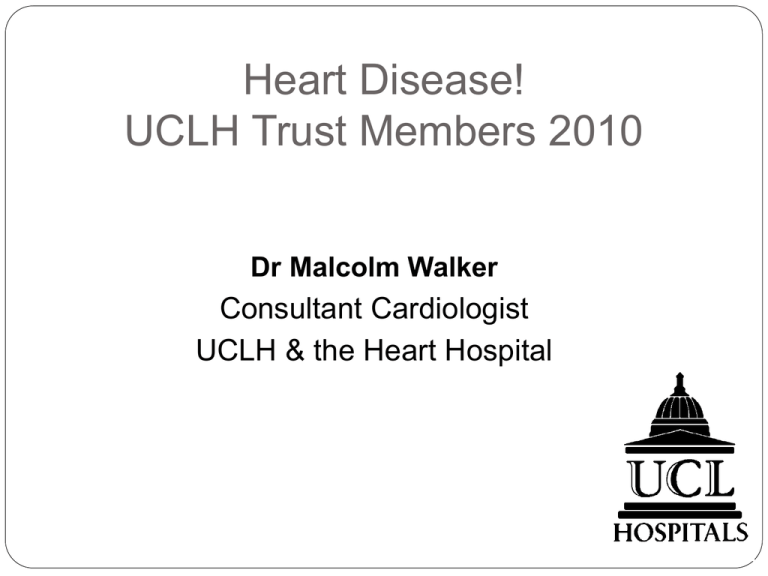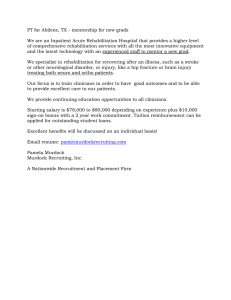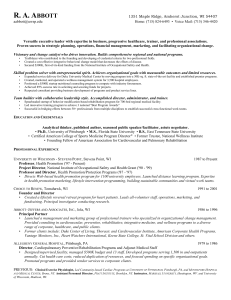Heart Disease! UCLH Trust Members 2010 Consultant Cardiologist UCLH & the Heart Hospital
advertisement

Heart Disease! UCLH Trust Members 2010 Dr Malcolm Walker Consultant Cardiologist UCLH & the Heart Hospital Dr Malcolm Walker Consultant Cardiologist - general adult interventional cardiologist with special interests in rehabilitation and myocardial iron overload Director of Hatter Cardiovascular Institute UCH Immediate past president British Association of Cardiovascular Rehabilitation (BACR) Scientific board member of the Thalassaemia International Federation (TIF – a WHO sponsored NGO - a patients & families lobby) Question “What treatment has randomised trial evidence of long term benefit by mortality reduction of >20%, morbidity reduction of a similar magnitude, causes weight loss, reduces blood pressure, improves mood, improves functional capacity, raises HDL cholesterol, improves glucose metabolism and does not cost the earth?” Heberden 1772 “one patient nearly cured himself of his angina” by retreating to his country estate “and sawing wood every day for some months” Case history: June 2003 59 yr old male Collapse – Rx DCC CPR Urgent angiography Urgent CABG Case history: June: Emergency CABG October ….. 7 Marathons in 7 days Does fitness affect survival ? • After Myocardial infarction • In primary prevention Cooper Clinic experience Blair et al JAMA 1989 % Dead 30 25 1 2 3 4 5 20 15 10 5 0 Category of Fitness from 1 (low) to 5 (very fit) Does fitness affect survival ? • After Myocardial infarction • In primary prevention Harvard alumni study Exercise No Moderate exercise Strong Very strong Overweight BMI>27.5 21% 16% 13% 10% Current smoker 17% 9.4% 6.8% 4.8% Alcohol >7/wk /wk 37% 42% 42% 44% Red meat >3/wk 40% 34% 29% 28% Vegetables < 6 /wk 30% 25% 23% 22% Harvard alumni study No Moderate exercise Strong Very strong Relative Risk of CHD Age adjusted 1.0 Referent 0.81 (0.62-1.04) 0.64 (0.48-0.85) 0.60 (0.440.81) Relative Risk of CHD Multivariate adj 1.0 Referent 0.81 (0.62-1.06) 0.62 (0.46-0.84) 0.60 (0.440.83) Relative Risk of CHD Multivariate adj 1.0 Referent 0.86 (0.66-1.13) 0.69 (0.51-0.94) 0.72 (0.521.00) REDUCED RISK 20% 40% 40% p for trend 0.0002 0.0003 0.02 Harvard alumni - summary • Self reported Borg-type scale useful • Graded benefit according to amount of exercise, when compared to those not doing any So not everybody has to wear lycra pants & join a gymnasium • Limitations of the study: – Men, American, higher social class Walking – benefit to high risk group demonstrated • Decreased death rate in diabetics – 2896 adults with diabetes – Those walking >2hr per week • 39% lower all cause mortality • 34% lower cardiovascular mortality – Largest benefit in those walking 3-4hr per week and for those reporting moderate increase in heart rate & breathing rate Arch Intern Med 2003; 163: 1440-1447 Exercise as therapy in CHD BUT can we provide an intervention that works? Cardiac Rehabilitation • The patients can do more • Their cholesterol is lower • They are taking their tablets regularly • They are no slimmer Is anything more being achieved for them? Cardiac Rehabilitation in CHD Taylor, R.S. et.al. Am J Med 2004 Hospitalised for CHD 48 RCTs, n= 8940 20% reduction in all cause mortality 24% in cardiovascular mortality Gains still evident when statins given to both arms of trial So exercise does matter Both for “victims” of CHD and as a method of prevention Cardiovascular Rehabilitation Why? Because there is good evidence that it helps Because we’ve been told to.. NSF CHD – Cardiac Rehabilitation Chapter 7 (Standard 12) “NHS Trusts should put in place agreed protocols/systems of care so that, prior to leaving hospital, people admitted to hospital suffering from coronary heart disease have been invited to participate in a multidisciplinary programme of secondary prevention and cardiac rehabilitation.” NSF Goal “Every hospital should ensure a) that more than 85% of people with a primary diagnosis of AMI are offered cardiac rehabilitation. Cardiovascular Rehabilitation Why? Because there is good evidence that it helps Randomised control trial (RCT) data Because we’ve been told to.. NSF Because there is an unmet need % Eligible patients offered CR England & Wales 1997 2000 2005 AMI 14 – 23 17 25 CABG 33 – 56 44 65 PCI 6 – 10 6 10 Surveys by Dr Hugh Bethel – BACR/BHF University College Hospital Foundation Trust Cardiovascular Health & Rehabilitation 2005 Co-operative bid with Camden PCT for BHF NOF funding – Grant £120,000 To develop a new self management method to deliver CR in association with Prof Stan Newman Aims to reduce DNA rates Improve adoption & maintenance of behaviour change Plan to roll out to whole sector & beyond if successful UCH Cardiovascular Health & Rehabilitation Patient recruitment Heart Hospital Cardiology patients identified from cath. lab database All receive standard letter or contacted by telephone Camden patients reviewed whilst in-patients – if time N.B. all Heart hospital patients (90+) are eligible for CR! Surgical patients referred by surgical audit team UCH Daily ward round AAU – most eligible patients will transfer to Heart Hospital Number of Patients referred to CR 2500 2000 1500 No. Patients 1000 500 0 2001 2002 2004 2005 Currently represents between 88-92 % of eligible patients Number of patients referred for CR at UCH CV Health 400 350 300 250 200 No. Patients 150 100 50 0 2001 2002 2004 2005 2006 UCH Cardiovascular Health & Rehabilitation 45 40 35 30 25 % DNA 20 15 10 5 0 pre 2005 2005 2006 UCH Cardiovascular Health & Rehabilitation Important service characteristics Close liaison with sector – rehabilitation task group Strategic alliance with central YMCA 2003 Exercise classes move out of hospital environment Exercise professionals supported through BACR training Flexibility – timing, course structure & content Evidenced by Patient choice funding & Combined BHF NOF bid Menu of choices for patients Early adoption of national (BACR/ BHF/ York University) minimum dataset Introduction of self-management programme UCH Cardiovascular Health & Rehabilitation New developments Expanded remit Heart failure – initially from hospital clinics, expanding to offer to primary care – now in full swing “Primary” prevention in diabetics – initially from hospital clinic with a view to expand to primary care – supports existing initiative of Camden Active Health Team Improve accessibility Walk in assessment service – as per R1 Pilot with one local primary care provider in first instance Conclusions on Cardiovascular Rehabilitation Task worth the effort Individuals committed to the service Trained to deliver high quality CR – use BACR/ ACPIR resources Good quality data CR evidence is compelling Anecdotal experience will amplify! National CR audit makes this easier Simple local databases are a starting point – get your kids to design you one! Good quality communication Fax, telephone, e-mail ! CR administrator invaluable/ sine qua non ? It’s mostly about teamwork!




